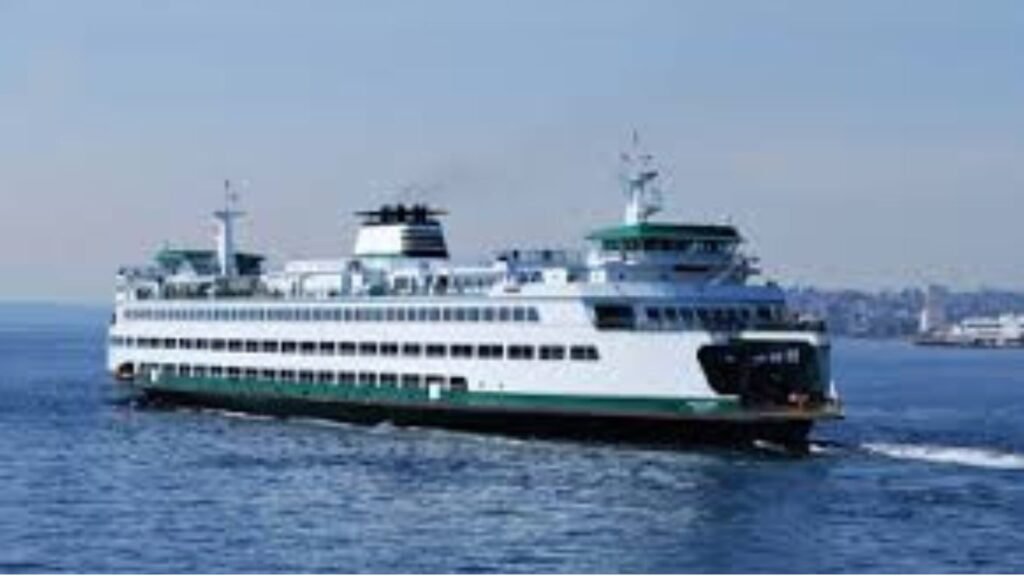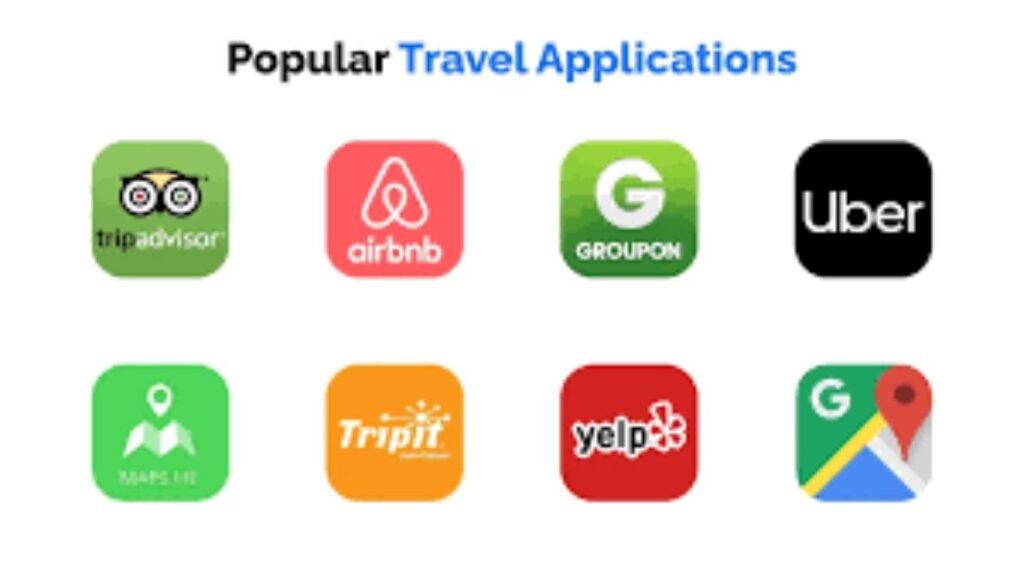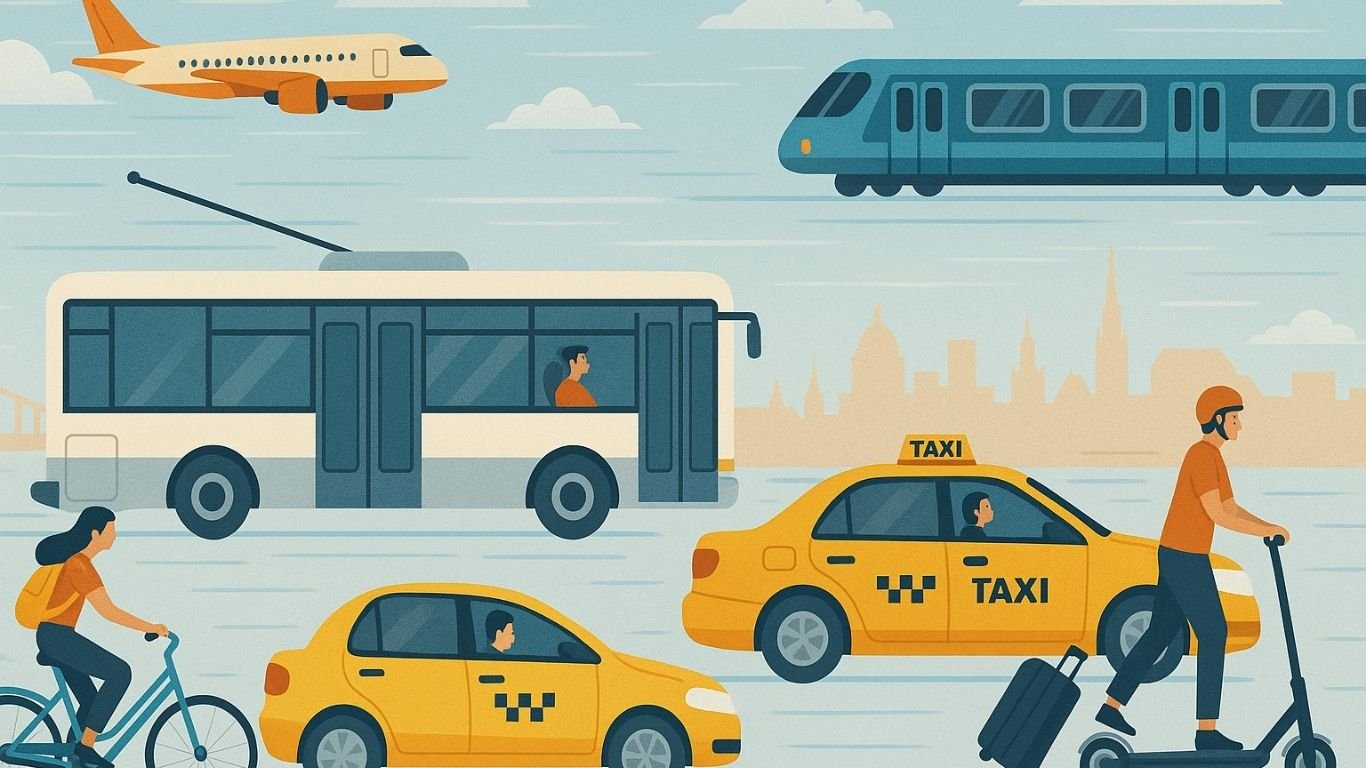Traveling offers an incredible sense of freedom—but figuring out how to get around while traveling can quickly turn that freedom into frustration. Whether it’s navigating an unfamiliar subway system, dealing with confusing signage in another language, or realizing too late that the last bus has left, transportation challenges are among the most common stressors travelers face.
This guide is designed to eliminate that stress. We’ll explore 15 of the smartest, most efficient ways how to get around while traveling, whether you’re exploring bustling cities, remote islands, or rugged mountain regions. Through detailed insights, practical tips, and firsthand experiences, you’ll discover not just how to move from place to place—but how to do it with ease, confidence, and even joy.
Table of Contents
1. Embrace Public Transportation
Public transportation is the lifeblood of many cities. It’s cost-effective, often faster than taxis in traffic-congested areas, and offers a fascinating window into daily life. Whether you’re in Tokyo, Paris, or Buenos Aires, using public transit not only saves money but enhances your cultural immersion.
Utilizing Local Buses and Trains
In many countries, buses and local trains are not just for commuting—they’re the most efficient way to see the landscape unfold between destinations. In places like India or Brazil, local trains are an adventure in themselves, offering views and experiences you’d never get from an airplane seat. In Scandinavia or Germany, punctuality and comfort reign supreme.
Before you board, take a few moments to understand the route. In some cities, bus stops have QR codes that link to live tracking apps. In others, such as in Southeast Asia, routes might be less formalized. Always ask locals or hotel staff if the routes are reliable or if you’ll need exact change (as in many U.S. cities).
A personal tip? In Eastern Europe, I once boarded a tram in Prague without a ticket, thinking I could buy one on board. I couldn’t—and a swift ticket inspection nearly cost me a hefty fine. Always check the rules of the system in advance.
Navigating Metro and Subway Systems
Metro systems are a traveler’s dream in major cities. Efficient, relatively easy to decipher, and immune to traffic, metros connect key tourist sites with local neighborhoods. Think of the London Underground, Paris Métro, or Seoul’s intricate subway labyrinth.
Each has its quirks. In New York, express and local trains share the same lines. In Tokyo, multiple private operators manage the network. The key is to download the specific metro map and study it for a few minutes. Focus on transfer points and color-coded lines, and remember that metro etiquette differs by region. Silence is golden in Japan, while music and lively conversation are common in Latin America.
Avoid rush hour if possible—it can be overwhelming, even claustrophobic. But off-peak, it’s often the quickest and cheapest way to get around.
Understanding Public Transport Apps
Modern travel has a secret weapon: transit apps. From Google Maps and Citymapper to Moovit and local apps like Rome2Rio or Transit App, these digital guides provide real-time schedules, estimated costs, and directions with step-by-step precision.
Citymapper is particularly effective in cities like London, New York, and Berlin, offering real-time train delays and even crowd-level predictions. Moovit works well globally and includes alerts for bus delays and strikes.
Always check if the app supports offline mode, especially if you’re traveling without a local SIM. Screenshots of transit maps or schedules can be a lifesaver when Wi-Fi is unavailable.
2. Walking and Cycling

There’s a certain romance in discovering a destination at your own pace—step by step, pedal by pedal. Walking and cycling offer a level of intimacy with your surroundings that no vehicle ever could. From cobblestone alleyways to scenic riverside paths, these methods provide freedom, flexibility, and a truly immersive travel experience.
Exploring Cities on Foot
Some of the world’s most captivating cities are best explored on foot. Venice, with its narrow canals and hidden courtyards, has no cars. Florence and Kyoto lure you into neighborhoods rich in texture, where every turn reveals a tucked-away café or an unexpected temple.
Walking also helps you observe the details—the scent of fresh bread, the echo of a violinist in a plaza, the colors of a local market. It’s how you find places that never appear in guidebooks.
That said, walking requires preparation. Invest in comfortable, broken-in footwear. Apps like AllTrails or Komoot are useful for mapping scenic routes, while Google Maps’ “walking” option is generally reliable. And remember: pace yourself. What looks like “just 2 km” on a map could include steep hills or uneven paths—especially in places like Lisbon or Istanbul.
Renting Bicycles and E-bikes
In recent years, bike rentals have exploded in popularity across the globe. From Paris’s Vélib’ to San Francisco’s Bay Wheels, urban bike-share systems offer a green, convenient way to cover more ground without compromising your connection to the environment.
E-bikes, in particular, have opened new doors for travelers who may not want to break a sweat or deal with hills. Cities like Amsterdam, Copenhagen, and Montreal have dedicated lanes and infrastructure that make cycling safe and seamless.
Rental stations are usually easy to find, but always check the terms: some require apps, deposits, or local credit cards. If you’re in a less urbanized area, ask guesthouses about day-long rentals. In rural France, for instance, I once spent a blissful afternoon pedaling between vineyards, entirely off the tourist radar.
Following Designated Cycling Paths
Dedicated cycling paths are more than just lines on a map—they’re thoughtfully designed corridors through culture and nature. The Danube Bike Trail takes you through medieval towns. The Cape Cod Rail Trail offers stunning Atlantic views. In Kyoto, a riverside bike path connects temples with cherry blossom trees in spring.
These routes are often well-marked and come with signage in multiple languages. Use apps like Komoot or Bikemap to plan your route, and always wear a helmet (even if locals don’t). Respect traffic rules and yield to pedestrians, especially in shared spaces.
Cycling and walking don’t just get you from one attraction to another—they make the journey itself unforgettable.
3. Ride-Sharing and Taxis

When you’re jet-lagged, lost, or carrying heavy luggage, sometimes the simplest solution is the most direct one. Ride-sharing apps and local taxis offer door-to-door convenience, and when used wisely, they can reduce transportation stress significantly—especially during late-night arrivals or in regions with less accessible public transit.
Using Ride-Sharing Apps
Apps like Uber, Lyft, Bolt, and Grab have revolutionized local transport in cities around the world. With just a few taps, you can summon a car, track its arrival in real time, and know the fare upfront. No need to haggle, worry about currency confusion, or explain your destination in a foreign language.
But there’s a caveat—availability varies. While Uber is widespread in North America and much of Europe, Grab dominates Southeast Asia. In Eastern Europe, Bolt is often the go-to choice. Always check which app is most popular in your destination and download it ahead of time. Some require local phone numbers for registration, so Wi-Fi access or a travel SIM is essential.
Personally, I’ve used ride-shares in over a dozen countries. One late night in Bogotá, Uber was my safest bet after a delayed flight. Just make sure to confirm the license plate and driver’s name before getting in. Safety first.
Understanding Local Taxi Services
Traditional taxis still play a major role in travel transportation—especially in regions where ride-sharing apps are banned or unavailable. In Morocco, Thailand, and parts of Central America, flagged taxis remain the primary option.
Here’s where research pays off. In some cities, like Tokyo or Berlin, taxis are strictly regulated and metered. In others, like Cairo or Manila, it’s customary to negotiate a fare upfront. In places with a reputation for overcharging tourists, ask your hotel for advice—or better yet, have them call a trusted cab for you.
Pro tip: always carry small bills in the local currency. Drivers might claim they have no change, especially when fares are low.
Pre-Booking Airport Transfers
After a long-haul flight, navigating unfamiliar airport exits and figuring out your next step can be daunting. That’s where pre-booked airport transfers shine. Whether arranged through your accommodation or a private company, these services offer peace of mind.
Sites like Welcome Pickups, Blacklane, or even your hotel concierge can arrange door-to-door pickups with English-speaking drivers who wait for you at arrivals with a sign. It’s a bit more expensive, yes—but worth every cent after 20 hours in transit.
In my own travels, I once landed in Delhi at 3 a.m. with no data and no sense of direction. That pre-booked ride waiting for me at the gate felt like a blessing.
4. Renting a Car

Sometimes, the open road calls. Whether you’re chasing the Northern Lights in Iceland, winding through the cliffs of Amalfi, or road-tripping across the American Southwest, renting a car offers unmatched flexibility. It allows you to explore remote villages, scenic byways, and national parks at your own pace—on your own terms.
Choosing the Right Rental Car
The first step? Match the car to the terrain. In mountainous or rugged regions (like Patagonia or the Scottish Highlands), a 4×4 may be essential. For city driving in Europe or Japan, a compact car is easier to park and more fuel-efficient.
Automatic or manual? Many international travelers overlook this detail and find themselves in a stick-shift car on winding alpine roads. Double-check the transmission type when booking—especially outside North America, where manuals are more common.
Consider fuel policy, insurance coverage, and mileage limits. Reputable platforms like DiscoverCars, Rentalcars.com, or even aggregators like Kayak offer transparent comparisons and user reviews.
And don’t forget about one-way rentals—ideal for longer road trips where you won’t return to the same place you started.
Understanding Local Driving Laws
Driving laws can vary dramatically by country—and ignorance is never an excuse. In Germany, for example, the autobahn has sections with no speed limit but also strict lane discipline. In Australia, you’ll drive on the left and need to watch for wildlife. In Italy, ZTL (limited traffic zones) in city centers can incur hefty fines if you enter without a permit.
Always research local driving customs, road signs, and legal requirements. You may need an International Driving Permit (IDP), available for a small fee in most countries. It’s accepted in over 150 nations and often required in non-English-speaking countries like Japan or Greece.
Pro tip: use Google Street View to preview your route. It’s helped me anticipate tricky intersections, toll booths, or narrow alleys in advance.
Using GPS and Navigation Systems
A good navigation system transforms your driving experience. Google Maps is the global standard, but apps like Waze provide real-time traffic alerts and police trap notifications (especially useful in the U.S. or Latin America).
Offline maps are essential for rural or mountainous regions where signal drops. Apps like Maps.me or Here WeGo allow you to download entire countries for free.
Some rental companies offer GPS units for an extra charge, but your smartphone—with a car mount and charger—is usually more reliable and familiar.
And here’s a personal recommendation: always plan fuel stops ahead of time. In Iceland, I once found myself on a vast, windswept road with no gas station in sight for 100 kilometers. Lesson learned.
5. Utilizing Ferries and Boats

Waterways have been connecting travelers for centuries. While planes and trains dominate modern travel, ferries and boats offer something different—slower, more scenic, and often far more relaxing. Whether island-hopping in the Mediterranean or navigating a river in Southeast Asia, traveling by water opens up new worlds.
Island Hopping with Ferries
In destinations like Greece, Croatia, Thailand, and Indonesia, ferries are not just a scenic option—they’re often the only link between islands. Some operate like clockwork, with fixed schedules and online bookings. Others are more spontaneous, leaving when full or when conditions allow.
Ferry types range from slow, traditional boats to sleek high-speed catamarans. High-speed options are great for saving time, but they tend to be more expensive and rougher in choppy waters. Traditional ferries might take longer, but they often have open-air decks, making the journey part of the experience.
Always book ferries in advance during peak travel seasons. Websites like Ferryhopper (Europe), Direct Ferries, and 12Go (Asia) simplify the process and compare routes. And remember: ferry ports can be chaotic. Arrive early, especially in busy hubs like Piraeus (Athens) or Phuket.
River Cruises and Water Taxis
In cities built around rivers or canals, water transport blends beauty with practicality. Think of Bangkok’s Chao Phraya River, the canals of Amsterdam, or the vaporetto system in Venice. These water taxis function much like buses, stopping at various piers along the riverfront.
They’re often more scenic and less crowded than ground-level options. In Bangkok, hopping on the orange-flag commuter boat lets you skip traffic and enjoy views of temples, palaces, and floating markets. In Venice, the vaporetto may not be luxurious, but it’s the cheapest way to cruise the Grand Canal.
River cruises, on the other hand, offer a slow-travel luxury alternative. Whether it’s a Danube cruise through Central Europe or a Nile journey in Egypt, they combine transport with cultural immersion.
Booking Tickets in Advance
Boats fill up—especially in tourist hotspots. Some routes operate only a few times per day, and weather delays are common. Book early online, especially if you’re traveling with luggage or during holiday periods.
Double-check the port of departure—some cities have multiple terminals that are far apart. Keep your tickets handy (digital copies usually suffice), and know the local boarding customs. In parts of Southeast Asia, boarding involves wading through shallow water or jumping from boat to boat. It’s all part of the adventure—but one best approached with prepared footwear and a flexible mindset.
6. High-Speed Trains

Few transportation modes combine efficiency, comfort, and elegance like high-speed rail. Gliding silently through countryside and cityscapes, these trains rival planes in convenience—often without the stress of airports. From France’s TGV to Japan’s Shinkansen, they redefine overland travel.
Benefits of High-Speed Rail
High-speed trains are fast—very fast. The French TGV reaches 320 km/h (199 mph), while the Chinese Fuxing Hao hits 350 km/h (217 mph). But speed isn’t the only draw. These trains depart from city centers, avoiding long airport transfers. Security lines are minimal. Boarding takes minutes.
Seats are spacious, Wi-Fi is common, and panoramic windows make the journey scenic. In Spain, you can reach Barcelona from Madrid in under three hours. In Japan, you’ll race past Mount Fuji with barely a sound. Onboard dining, quiet cars, and generous luggage allowances make high-speed rail ideal for stress-free travel.
There’s also an environmental advantage: trains emit significantly less CO₂ per passenger than planes or cars, making them a more sustainable choice.
Booking Tickets and Reservations
The golden rule? Book early. Not only will you secure your seat—often required on high-speed routes—but you’ll get better prices. European sites like Trainline, Rail Europe, and SNCF Connect make it easy to compare routes and book tickets in your own language.
In Asia, platforms like Japan Rail Pass, 12Go, or even local rail apps are efficient and often offer discounted tourist passes. For Japan’s Shinkansen, foreign travelers can pre-order a JR Pass, giving unlimited travel for a set number of days—a massive savings if used strategically.
Be sure to reserve your seat if required. In Italy’s Trenitalia and Spain’s Renfe, seat reservations are mandatory for high-speed lines—even with a rail pass.
Planning Long-Distance Travel
High-speed rail excels at connecting major hubs. Paris to Milan, Tokyo to Osaka, Beijing to Shanghai—all are smoother by train than by air when factoring in airport time. But to get the most out of your journey, plan with intention.
Allow time for layovers in charming secondary cities. Split a long trip into two or three legs and explore en route. On a recent journey from Berlin to Zurich, I stopped overnight in Freiburg—a storybook town I’d never have seen had I flown.
Always check schedules in advance, especially for early departures. While most high-speed trains run like clockwork, track work or national holidays can disrupt service.
7. Domestic Flights

While overland travel has its charm, sometimes distance demands altitude. In vast countries like the United States, Canada, Australia, or Brazil, domestic flights save time—turning what would be a multi-day journey into a matter of hours. When chosen wisely, they’re not only efficient but surprisingly affordable.
Finding Affordable Domestic Flights
Budget airlines have reshaped domestic travel. Carriers like Southwest (U.S.), Ryanair (Europe), Jetstar (Australia), and Gol (Brazil) offer competitive fares, especially when booked early. Use aggregators like Skyscanner, Google Flights, or Hopper to track prices and compare routes.
Set fare alerts weeks in advance—especially if your travel dates are fixed. Midweek flights (Tuesdays and Wednesdays) are typically cheaper, and early morning or late-night options often offer additional savings.
However, always read the fine print. Budget airlines may charge for checked bags, seat selection, and even carry-ons. What seems like a steal can double in price by checkout.
Personally, I’ve scored $30 flights across Colombia on Viva Air and under $50 fares between Bangkok and Chiang Mai. Flexibility and vigilance make a huge difference.
Navigating Airport Security
Domestic airports vary wildly in size and efficiency. In Tokyo or Zurich, you’ll breeze through security with military precision. In large U.S. hubs like LAX or JFK, expect long lines and delays.
Arrive at least 90 minutes before departure. Have your boarding pass ready—most airlines offer mobile versions through their apps. Pack your carry-on mindfully: liquids in 100ml containers, laptops out, shoes off (depending on the country).
TSA PreCheck (U.S.), NEXUS (Canada), or SmartGate (Australia) can save frequent travelers time. If you’re traveling with only a backpack, use that agility to your advantage—smaller lines and quicker boarding.
Utilizing Airport Lounges
Lounges aren’t just for business travelers anymore. With day passes, credit card perks (like Priority Pass or AmEx Platinum), or certain airline memberships, you can access comfortable lounges that offer Wi-Fi, food, drinks, and quiet zones.
They’re especially valuable during layovers or delays. Instead of sitting on plastic chairs near a charging station, imagine sipping tea in a quiet corner while planning your next adventure. For $30–$50, lounges offer peace of mind, especially in unfamiliar airports.
Pro tip: LoungeBuddy (app) helps you find lounges you can access based on your tickets and cards.
8. Hitchhiking (With Caution)

Hitchhiking may conjure images of carefree backpackers and spontaneous road trips, but in the right context—and with the right precautions—it remains a viable and surprisingly rewarding way to get around. It offers not only free transport, but often genuine human connection and off-the-beaten-path adventures. Still, it’s a method that demands caution, cultural awareness, and flexibility.
Safety Considerations and Precautions
Safety is paramount. Hitchhiking isn’t suitable everywhere, and even in traditionally friendly countries, you must weigh personal comfort and local conditions. Always hitchhike in daylight, preferably near gas stations, rest stops, or highway on-ramps where it’s legal and expected.
Travel with a partner when possible. Solo travelers—especially women—should approach this method cautiously. Trust your instincts. If something feels off about a driver or situation, politely decline the ride. Let someone know your route, license plate number, and estimated arrival.
Carry a simple sign with your destination, and keep essentials like ID, phone, water, and a backup plan handy. A polite smile and clean appearance go a long way.
From personal experience hitchhiking through rural Romania, I’ve learned that kindness from strangers is real—but so is the need for common sense. Choose your rides as carefully as you choose your companions.
Understanding Local Hitchhiking Customs
In some countries, hitchhiking is culturally accepted—even expected. In parts of Eastern Europe, the Caucasus, Central America, and New Zealand, locals pick up travelers regularly. In others, like the U.S. or Western Europe, it’s less common and often misunderstood.
Signs in the local language help. In countries like Germany, standing at designated “Mitfahrbank” benches (ride-share benches) shows intent and increases success. In Israel, hitchhiking (tremping) is structured, with known pickup points and common routes. Research local laws—some countries have restrictions or specific rules about hitching on highways.
Know that hitchhiking speed varies. It could take minutes to get picked up in Georgia or Poland, or hours in rural Canada or Spain. Patience is part of the journey.
Using Hitchhiking Apps (If Available)
Technology has even entered the hitchhiking world. Apps like BlaBlaCar, while technically carpooling platforms, offer a modern, semi-structured version of hitching a ride. Drivers list planned routes and available seats, and you can book a ride at a fraction of the cost of trains or buses—often with more comfort and conversation.
Hitchwiki.org is another valuable resource, offering detailed user-submitted tips on the best hitching spots around the world. Trustpilot reviews of specific apps, local Facebook groups, or even Couchsurfing forums can help you find rides safely and responsibly.
Hitchhiking is not for every traveler, nor for every destination. But when approached with knowledge, precaution, and respect, it can be one of the most serendipitous ways to connect with people and places.
9. Organized Tours and Shuttles

When your destination is complex, remote, or simply packed with logistics, organized tours and shuttle services can take the stress off your shoulders. These options streamline transportation and often include local insight, cultural context, and a dash of social connection—ideal for travelers who want convenience without sacrificing experience.
Joining Group Tours
Group tours are not just for package tourists. In many parts of the world, they’re a smart, efficient way to explore otherwise inaccessible places. From day trips to multi-day itineraries, tours offer door-to-door transport, knowledgeable guides, and pre-arranged logistics.
Think glacier hikes in Iceland, wine tasting in Argentina’s Mendoza region, or safaris in Tanzania. These experiences demand local expertise and specific transport—joining a group makes them seamless.
Choose wisely. Opt for companies with strong ethical practices, small group sizes, and well-reviewed guides. Platforms like GetYourGuide, Viator, and Intrepid Travel offer transparent booking and ratings. Personally, I’ve found that group tours often reveal deeper stories—from hidden ruins to secret food stalls—that I might’ve missed on my own.
Using Hotel Shuttle Services
Many hotels and hostels—especially in major cities and resort areas—offer complimentary or affordable shuttle services to and from airports, city centers, or popular attractions. These are often underutilized gems for hassle-free mobility.
Check with your accommodation before arrival. A simple email or website visit can reveal scheduled departures, pickup procedures, and whether reservations are required. Some hotels even partner with local transportation providers to offer customized excursions or multi-stop shuttles.
Shuttles are particularly valuable in destinations with confusing or unreliable public transport—think Cancun, Dubai, or Marrakech. They’re also safer and more reliable for solo or late-night travelers.
Booking Airport Shuttle Buses
Airport shuttle buses strike a middle ground between public transport and private taxis. They follow fixed routes, run on predictable schedules, and cost significantly less than a cab. In cities like Rome, Bangkok, or New York, they’re often the most economical way to get from airport to city center.
These buses cater specifically to travelers: ample luggage storage, comfortable seating, and minimal stops. Companies like Terravision (Europe), Flybus (Iceland), or Supershuttle (U.S.) are among the most well-known. Book in advance during peak travel times, and confirm the pickup point—it’s not always obvious, especially in sprawling airports.
One tip: while these shuttles are usually punctual, traffic delays can happen. If you’re catching a flight, build in extra buffer time to be safe.
10. Travel Passes and Cards

Smart travelers know that a little investment upfront can translate into significant savings and seamless movement later. Travel passes and transport cards simplify access, reduce individual ticket costs, and help you navigate systems without fumbling for coins or translating unfamiliar pricing charts. Whether you’re in a single city or crossing borders, these passes offer freedom and financial efficiency.
City Travel Cards
Major cities often offer all-in-one travel cards that cover unlimited rides on buses, subways, trams, and even some ferries. Think the Oyster Card in London, Navigo in Paris, Octopus Card in Hong Kong, or Suica/PASMO in Tokyo.
These cards are not just convenient—they often come with discounted fares, faster boarding, and access to other services like bike rentals or vending machines. Some cities offer tourist versions valid for 24, 48, or 72 hours with additional perks like museum entry or restaurant discounts.
I once used a Vienna City Card, which not only gave me unlimited transport but also 20% off at historic cafés and guided tours. A small upfront fee led to big savings and less logistical stress.
Always check if the card needs to be validated before your first ride—some cities are strict about this.
Rail Passes
For intercity or cross-country travel, rail passes are your golden ticket—literally. The Eurail Global Pass allows non-Europeans to travel freely across 33 countries on most major train networks. For residents of Europe, the Interrail Pass serves a similar function. In Japan, the Japan Rail Pass is a no-brainer for travelers covering more than one city.
These passes often include high-speed trains, scenic routes, and sometimes ferries. But be aware: seat reservations might be required on certain lines, and not all private trains are covered.
Before buying, compare the pass cost against individual ticket prices for your planned route. For short, one-off trips, individual tickets may be more economical. But for ambitious itineraries—like Paris to Berlin, Vienna to Budapest, and Prague to Krakow—a rail pass can unlock real savings and spontaneity.
Discounted Travel Options
Many transport networks offer discounted passes for students, seniors, or families. National bus systems, like FlixBus in Europe or Greyhound in the U.S., often run multi-ride discount cards or regional passes.
In Switzerland, the Swiss Travel Pass gives you unlimited travel on trains, boats, and buses—and even covers entry to 500+ museums. In South Korea, the Korail Pass unlocks a high-speed journey across the country for a fraction of the normal cost.
These passes are best booked in advance and often require proof of age, nationality, or travel dates. Always read the fine print to avoid surprises.
11. Travel Apps for Navigation

In the digital age, getting lost is optional. With the right apps, your phone becomes a personal guide, interpreter, and real-time travel assistant. Navigation apps have revolutionized how travelers move—from deciphering subway systems to translating street signs and avoiding closed roads or missed stops.
Mapping and Direction Apps
Google Maps remains the industry leader for good reason. It offers accurate, turn-by-turn directions for walking, driving, biking, and public transit in most cities worldwide. You can download offline maps in advance—especially helpful in areas with poor connectivity or limited data access.
Apps like Maps.me and HERE WeGo shine in offline navigation. They’re ideal for trekking through nature reserves, remote towns, or countries where international roaming is costly. Personally, I’ve used Maps.me in places like Bolivia and rural Georgia, where other apps had zero signal—and it never let me down.
For more adventurous travelers, Komoot and AllTrails are excellent for hiking and cycling. They provide terrain details, elevation profiles, and community-shared tips for routes off the beaten path.
Real-Time Transit Updates
Public transit isn’t static. Delays, reroutes, and closures happen daily—especially in dense cities. That’s where apps like Citymapper, Moovit, and Transit App become essential.
Citymapper excels in cities like London, New York, and Berlin. It breaks down your journey step by step, including walking times, transfer platforms, and even how crowded a train might be. Moovit is available in over 3,000 cities worldwide, offering accessibility features and alerts for strikes or detours.
In countries like Japan or South Korea, use local apps like Navitime or KakaoMetro for more accurate train schedules and station layouts.
Enable push notifications to stay informed in real time, especially if you’re navigating during peak hours or tight layovers.
Language Translation Apps
Language barriers are less intimidating when you have digital help. Google Translate now offers instant camera translation—just point your lens at a sign, menu, or schedule, and see the translation in your language. It supports dozens of languages and works offline if downloaded in advance.
Apps like Papago (great for Korean), iTranslate, or SayHi offer additional language support, including spoken translations that bridge conversational gaps with taxi drivers or train conductors.
A personal tip? Keep key phrases saved in the app—things like “Where is the nearest station?” or “Does this bus go to the airport?” can save you in a pinch.
Technology isn’t a crutch—it’s a travel companion that helps you move smarter and more confidently.
12. Packing Light for Easier Transit
Every traveler eventually learns the golden rule: the less you carry, the more freely you move. A heavy suitcase or overstuffed backpack doesn’t just weigh down your body—it slows your pace, limits your transport options, and turns travel from adventure into burden. Packing light isn’t just about minimalism; it’s about freedom.
Minimizing Luggage
The first step is mindset. Ask yourself: Do I really need this? Chances are, you don’t. Most trips—whether one week or one month—require the same core items. Stick to neutral, mix-and-match clothing. Two pairs of shoes are usually enough: one for walking, one for style or activity.
Choose luggage that fits the journey. A small rolling carry-on is perfect for urban travel with paved sidewalks and elevators. For trekking, a 40- to 50-liter backpack keeps your hands free and your load manageable.
Remember, budget airlines and trains often charge for checked bags—or have limited storage space. I once traveled for 10 days across Japan with just a small daypack and never felt deprived.
Using Packing Cubes
Packing cubes are a game changer. These zippered fabric containers keep your clothes compressed, organized, and easy to access. Use one for tops, one for bottoms, and one for undergarments. Color-code if needed. They make unpacking and repacking—especially during multi-stop trips—far less chaotic.
Vacuum-seal bags can also help if you’re bringing bulkier items like jackets or sweaters. But don’t overdo compression—you want your items accessible without needing to unpack everything on a train platform.
Compression packing is especially helpful when you’re relying on multiple transit methods in a day—ferry to train to metro, for instance. Less shifting, fewer surprises.
Carrying Essentials in a Backpack
Keep your essentials with you at all times. A well-organized daypack or small backpack should contain:
- Passport and ID
- Travel documents and tickets
- Water bottle
- Snacks
- Phone and charger
- Lightweight rain jacket
- Medications and small first-aid kit
Choose a pack with hidden or secure compartments to deter pickpockets, especially in crowded transport hubs. Wear it on your front when boarding buses or trains, and keep it tucked close during layovers or border checks.
My personal rule: if I can’t carry everything I need up a flight of stairs unassisted, I’ve packed too much.
Light packing equals light thinking. It frees you to hop on local buses, jump into a tuk-tuk, or climb the hill to a mountaintop guesthouse—without wondering how to lug your suitcase behind you.
13. Planning Ahead and Researching Options
Spontaneity has its place in travel, but when it comes to transportation, a little planning goes a long way. Understanding your options ahead of time can save hours, prevent missteps, and help you move through unfamiliar territory with confidence and ease.
Pre-Booking Tickets and Accommodations
The earlier you book, the more options you have—and the better the prices. This applies to nearly every form of transport: high-speed trains, intercity buses, flights, and ferries. Many routes—especially popular ones in Europe or Asia—sell out quickly during peak seasons.
Pre-booking also reduces stress on arrival. Instead of negotiating at a crowded terminal or deciphering signage in a foreign language, you’ll already have your seat reserved, confirmation in hand, and a timeline to follow.
Platforms like Omio, 12Go, Rome2Rio, and Trainline are great for comparing transport options across regions. They often show whether a route is better by bus, train, or plane—including total duration and transfers.
For accommodations, booking a place near transport hubs (like metro stations or bus terminals) can dramatically ease your daily movements. I always prioritize walking distance to transit, especially in cities with intense traffic like Manila or São Paulo.
Checking Transportation Schedules
Schedules vary by day, region, and even time of year. In rural or less-touristed areas, buses may only run a few times a day—or not at all on Sundays. Trains can be suspended due to strikes, maintenance, or weather disruptions.
Double-check official websites or local apps the night before your departure. Look for notes about platform changes, alternate stations, or substitute buses. This is especially crucial for ferries and long-distance trains, where missed departures mean long waits or expensive rebookings.
Take screenshots of timetables in case your internet cuts out. In places like Morocco or Bolivia, I’ve relied on printed bus times photographed the night before when real-time data wasn’t available.
Understanding Local Customs and Etiquette
Transportation isn’t just about vehicles—it’s about people and norms. In some cultures, queueing is sacred (like the UK or Japan). In others, boarding might be more chaotic, with a “first come, first push” rhythm. Understanding the difference helps you navigate respectfully—and avoid unnecessary frustration.
Pay attention to how locals behave. Is tipping customary for taxi drivers? Are you expected to offer your seat to elders? Should you enter buses at the front or middle door?
In Vietnam, honking is a friendly warning, not a sign of anger. In Sweden, buses won’t stop unless you signal clearly. In Argentina, paying with coins is essential for some older transport systems.
By researching local customs in advance, you become not just a tourist—but a respectful participant in the daily rhythm of your destination.
14. Staying Flexible and Adaptable
Even the best-laid travel plans encounter hiccups. A delayed bus, a canceled flight, a misread map—it’s all part of the journey. The real trick isn’t avoiding disruptions altogether (that’s impossible), but learning to stay calm, pivot gracefully, and adapt your plans with confidence. Flexibility is not just a mindset—it’s a skill that transforms travel stress into adventure.
Dealing with Unexpected Delays
Delays happen. Strikes in France, rainstorms in Southeast Asia, or a surprise national holiday can halt transportation in an instant. The key is to expect the unexpected.
Always build in buffer time. If you’re catching a flight after a train journey, give yourself a few extra hours. If you’re heading to a border crossing, assume it might take longer than Google says.
Download entertainment, bring snacks, and keep an external battery charger for your phone. These small comforts can turn a long wait into a moment of rest and reflection rather than a breakdown in morale.
Personally, I once spent eight hours stuck on a bus from Istanbul to Sofia due to snow. What saved me? Patience, downloaded audiobooks, and a bit of humor.
Having Backup Plans
Think of transport planning like chess—you should always know your next two moves. If your ferry is canceled, what’s the overland option? If the train is full, is there a rideshare or overnight bus available?
Apps like Rome2Rio and Google Maps are helpful for quick alternates. Keep a mental (or written) list of options. Know the nearest station, alternate bus company, or whether renting a car could be a fallback solution.
In more remote areas, consider carrying a local SIM card or a portable hotspot. Connectivity can make the difference between standing still and rerouting within minutes.
Also, insure your plans—especially flights or expensive train journeys. Travel insurance with transportation coverage can reimburse you for missed connections or cancellations due to external factors.
Embracing Spontaneity
Some of the best travel moments are unplanned. You might miss a bus, only to discover a local café where strangers become friends. You might detour through a lesser-known town that becomes the highlight of your trip.
While planning is essential, rigidity can become a trap. Allow yourself to follow your curiosity. Stay an extra night somewhere unexpectedly delightful. Take the slower train that passes through the countryside instead of the express.
Adaptability is about more than changing your route—it’s about changing your attitude. Every misstep is a potential story, a memory in the making.
15. Prioritizing Comfort and Safety
Travel isn’t just about reaching your destination—it’s about how you feel while getting there. Prioritizing your physical comfort and personal safety helps you move more confidently and enjoy the experience, no matter the distance or mode of transport. Thoughtful preparation ensures your energy is spent on wonder, not worry.
Choosing Comfortable Footwear
Your feet are your most reliable form of transport, and yet they’re often overlooked. Whether you’re crossing terminals, climbing cobbled streets, or standing on crowded buses, your shoes should support and protect you.
Choose footwear based on your destination. Breathable sneakers for urban exploration, waterproof boots for hikes or rainy regions, and compact sandals for beach towns. Break them in before your trip—blisters can derail even the most carefully planned itinerary.
Personally, I never travel without a pair of reliable walking shoes and lightweight slip-ons for flights and casual days. The comfort you gain pays off tenfold in stamina and mood.
Staying Hydrated and Well-Rested
Transit zones often dehydrate you—planes especially. Bring a reusable water bottle and refill often. Many airports, train stations, and city parks have safe drinking fountains. If you’re unsure, use a bottle with a built-in filter like LifeStraw or GRAYL, which are great for regions where water safety is a concern.
Rest is equally critical. Overplanning back-to-back transit legs can exhaust even experienced travelers. Schedule breaks, nap when you can, and don’t underestimate the restorative power of a quiet hour in a lounge, café, or shaded bench.
Sleep during overnight trips can be improved with a neck pillow, eye mask, and noise-canceling headphones. Apps like Calm or Headspace offer meditations and ambient sounds for better rest on the go.
Ensuring Personal Safety and Security
Wherever you go, stay aware of your surroundings. Keep valuables in secure, hidden pockets. RFID-blocking wallets or passport holders add a layer of security, especially in cities with high pickpocket activity.
Use anti-theft bags with lockable zippers and slash-proof straps. Keep digital backups of your passport and important documents in secure cloud storage. Share your itinerary with someone you trust.
In high-risk areas, avoid nighttime travel, choose reputable transportation providers, and stay informed about local scams. Government travel advisories and apps like Smart Traveler or Sitata provide real-time updates on safety concerns.
Above all, trust your instincts. If a situation feels off—whether it’s a ride, route, or recommendation—remove yourself without hesitation.
Feeling safe and comfortable isn’t a luxury while traveling. It’s the foundation that allows you to explore the world with joy and confidence.
